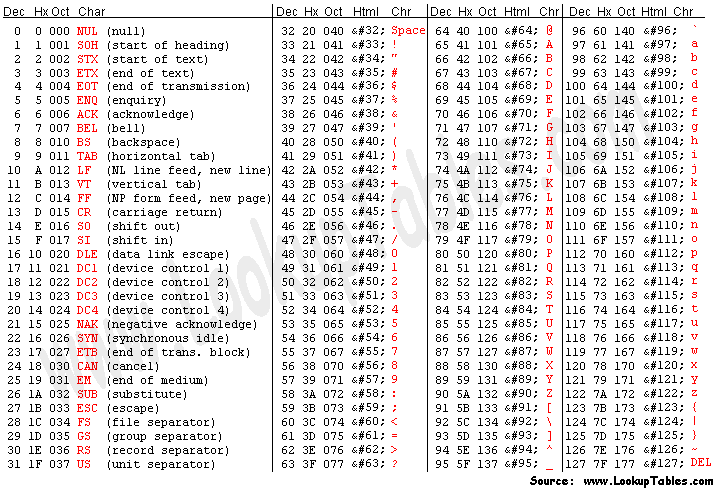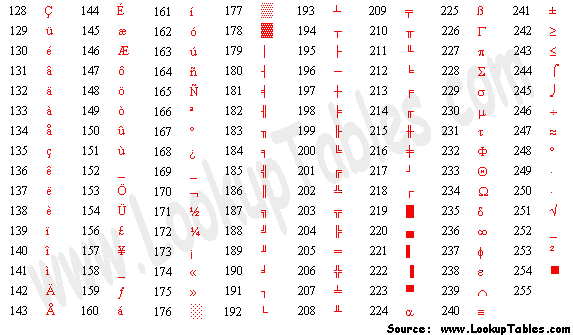ASCII
ASCII - (pronounced /ˈæski/) The American Standard Code for Information Interchange is a standard seven-bit code that was proposed by ANSI in 1963, and finalized in 1968, and maybe a guy named Robert W. Bemer was involved in the process. ASCII specifies a correspondence between digital bit patterns and character symbols. The purpose is to create a standard for computers, and other data processing equipment. ASCII developed from telegraphic codes and its first commercial use was as a seven-bit teleprinter code promoted by Bell data services.
The standard ASCII character set uses 7-bit code and consists of 128 decimal numbers ranging from zero through 127 assigned to letters, numbers, punctuation marks, and the most common special characters. The Extended ASCII Character Set also consists of 128 decimal numbers and ranges from 128 through 255 representing additional special, mathematical, graphic, and foreign characters. On common 8-bit systems, an 8th parity bit compliments the patterns of seven binary digits (a range of 0 to 127 decimal) which represent each ASCII character.
The later added extended ASCII characters were added to the original ASCII character set as the result of the computer industry specifically. MS-DOS uses a superset of ASCII called extended ASCII or high ASCII. The extended character set uses 8-bit encoding rather than 7-bit.
- control characters: ASCII reserves the first 32 codes (numbers 0–31 decimal) for control characters such as printer control and device control.
- printable characters: a space, letters, digits, punctuation marks, and printable symbols.
- extended characters: 8-bit later addition to the original ASCII characters include non-English characters, graphics symbols, and mathematical symbols.
Contents
[hide]ASCII Table Charts
The website LookupTables has two of the best ASCII table charts available.
Lower ASCII Table
source: http://www.lookuptables.com/
Upper ASCII Table
source: http://www.lookuptables.com/
Text ASCII Table
This chart is a text table rather than a graphic illustration.
| ASCII | HEX | DESC | ASCII | HEX | DESC | |
| 0 | 0 | NUL | 64 | 40 | @ | |
| 1 | 1 | SOH | 65 | 41 | A | |
| 2 | 2 | STX | 66 | 42 | B | |
| 3 | 3 | ETX | 67 | 43 | C | |
| 4 | 4 | EOT | 68 | 44 | D | |
| 5 | 5 | ENQ | 69 | 45 | E | |
| 6 | 6 | ACK | 70 | 46 | F | |
| 7 | 7 | BEL | 71 | 47 | G | |
| 8 | 8 | BS | 72 | 48 | H | |
| 9 | 9 | TAB | 73 | 49 | I | |
| 10 | A | LF | 74 | 4A | J | |
| 11 | B | VT | 75 | 4B | K | |
| 12 | C | FF | 76 | 4C | L | |
| 13 | D | CR | 77 | 4D | M | |
| 14 | E | SO | 78 | 4E | N | |
| 15 | F | SI | 79 | 4F | O | |
| 16 | 10 | DLE | 80 | 50 | P | |
| 17 | 11 | DC1 | 81 | 51 | Q | |
| 18 | 12 | DC2 | 82 | 52 | R | |
| 19 | 13 | DC3 | 83 | 53 | S | |
| 20 | 14 | DC4 | 84 | 54 | T | |
| 21 | 15 | NAK | 85 | 55 | U | |
| 22 | 16 | SYN | 86 | 56 | V | |
| 23 | 17 | ETB | 87 | 57 | W | |
| 24 | 18 | CAN | 88 | 58 | X | |
| 25 | 19 | EM | 89 | 59 | Y | |
| 26 | 1A | SUB | 90 | 5A | Z | |
| 27 | 1B | ESC | 91 | 5B | [ | |
| 28 | 1C | FS | 92 | 5C | \\ | |
| 29 | 1D | GS | 93 | 5D | ] | |
| 30 | 1E | RS | 94 | 5E | ^ | |
| 31 | 1F | US | 95 | 5F | _ | |
| 32 | 20 | (space) | 96 | 60 | ` | |
| 33 | 21 | ! | 97 | 61 | a | |
| 34 | 22 | " | 98 | 62 | b | |
| 35 | 23 | # | 99 | 63 | c | |
| 36 | 24 | $ | 100 | 64 | d | |
| 37 | 25 | % | 101 | 65 | e | |
| 38 | 26 | & | 102 | 66 | f | |
| 39 | 27 | \' | 103 | 67 | g | |
| 40 | 28 | ( | 104 | 68 | h | |
| 41 | 29 | ) | 105 | 69 | i | |
| 42 | 2A | * | 106 | 6A | j | |
| 43 | 2B | + | 107 | 6B | k | |
| 44 | 2C | , | 108 | 6C | l | |
| 45 | 2D | - | 109 | 6D | m | |
| 46 | 2E | . | 110 | 6E | n | |
| 47 | 2F | / | 111 | 6F | o | |
| 48 | 30 | 0 | 112 | 70 | p | |
| 49 | 31 | 1 | 113 | 71 | q | |
| 50 | 32 | 2 | 114 | 72 | r | |
| 51 | 33 | 3 | 115 | 73 | s | |
| 52 | 34 | 4 | 116 | 74 | t | |
| 53 | 35 | 5 | 117 | 75 | u | |
| 54 | 36 | 6 | 118 | 76 | v | |
| 55 | 37 | 7 | 119 | 77 | w | |
| 56 | 38 | 8 | 120 | 78 | x | |
| 57 | 39 | 9 | 121 | 79 | y | |
| 58 | 3A | : | 122 | 7A | z | |
| 59 | 3B | ; | 123 | 7B | { | |
| 60 | 3C | < | 124 | 7C | ||
| 61 | 3D | = | 125 | 7D | } | |
| 62 | 3E | > | 126 | 7E | ~ | |
| 63 | 3F | ? | 127 | 7F | | |
Control Character Details
- NUL (null)
- SOH (start of heading)
- STX (start of text)
- ETX (end of text)
- EOT (end of transmission) - Not the same as ETB
- ENQ (enquiry)
- ACK (acknowledge)
- BEL (bell) - Caused teletype machines to ring a bell. Causes a beep in many common terminals and terminal emulation programs.
- BS (backspace) - Moves the cursor (or print head) move backwards (left) one space.
- TAB (horizontal tab) - Moves the cursor (or print head) right to the next tab stop. The spacing of tab stops is dependent on the output device, but is often either 8 or 10. LF (NL line feed, new line) - Moves the cursor (or print head) to a new line. On Unix systems, moves to a new line AND all the way to the left.
- VT (vertical tab)
- FF (form feed) - Advances paper to the top of the next page (if the output device is a printer).
- CR (carriage return) - Moves the cursor all the way to the left, but does not advance to the next line.
- SO (shift out) - Switches output device to alternate character set.
- SI (shift in) - Switches output device back to default character set.
- DLE (data link escape)
- DC1 (device control 1)
- DC2 (device control 2)
- DC3 (device control 3)
- DC4 (device control 4)
- NAK (negative acknowledge)
- SYN (synchronous idle)
- ETB (end of transmission block) - Not the same as EOT
- CAN (cancel)
- EM (end of medium)
- SUB (substitute)
- ESC (escape)
- FS (file separator)
- GS (group separator)
- RS (record separator)
- US (unit separator)
Other Facts
The ASCII Group
There is a small private company called ASCII, or The ASCII Group, which has absolutely nothing to do with the American Standard Code for Information Interchange. The private company's use of the name ASCII should be challenged in court, but this has yet to happen. All of the combined technical intellect of this company couldn't devise a toddlers ABC picture table, let alone a standard set of codes for electronic equipment and computers.
ASCII Art
When presented with a text based terminal only, the creative genius of the human mind still can produce art. With origins in the computer bulletin board systems of the late 1970s and early 1980s, ASCII characters were used to form pictures. Other places where ASCII art can be created is on typewriters, teletypes, text printers, modem BBS, e-mail, and Usenet.
____ _____ ______________ ____ ____ ______ / _ | / ___// ____/ _/ _/ / _ | / __ \/_ __/ / /_| | \__ \/ / / / / / / /_| | / /_/ / / / / /__| | __/ / /___ / / / / / /__| |/ / / / / / /_/ |_/____/\____/___/___/ /_/ |_/_/ |_| /_/
Emoticons
On text based chat mediums, starting with IRC (Internet Relay Chat) individuals used a combination of 2 or more characters to represent a mood or emotion. The most basic example is the smile :) if you tild your head 90 degrees left you will see the colon represents two eyes and the closing parenthesis represents the smiling mouth.
Claims of earlier use of emoticons can be traced back to the early 80's (before IRC) with the use of the 3 character combination :-) to indicate a joke and :-( to indicate something that is not meant to be a joke.

